Description: The central item of the patch is a fierce representation of a thunderbird on a black-bordered triangular field of silver. The triangle is on a blue, white-bordered, circular field. The thunderbird is bright yellow, outlined in royal blue. Three black concentric triangles are superimposed on its chest. The numeral “27” is emblazoned on the bird’s tail feathers, directly below the triangles.
Significance: The thunderbird was a symbol to the early Indians inhabiting Colorado. It ruled the skies and produce thunder, lightning, and rain. On the patch, the thunderbird represents the Air Force’s dominance of the skies. The silver triangle is a stylized aircraft and the three concentric triangles represent three cubed, or twenty-seven. The patch contains the four Academy class colors representing the unity of the wing.
History: This is the original squadron patch and was designed by Donald Bowers, Jr., Class of 1970.
Nickname: "Thunderbirds"
 1968 –
1968 –













